自己开发了一个股票智能分析软件,功能很强大,需要的点击下面的链接获取:
https://www.cnblogs.com/bclshuai/p/11380657.html
Qt动画
目录
1 简介
1.1 Qt动画类介绍
2 基础动画实现
2.1 Qt控件大小缩放和位置变化
2.2 透明度控制隐藏和显示
2.3 并行动画
2.4 串行动画
2.5 动画执行方向设置
2.6 动画循环次数设置
2.7 动画执行结束的操作
3 Qt的高级动画应用
3.1 Qt自定义动画属性实现背景色透明度动画
3.2 Tab条选择跟随移动
3.2.1 应用场景说明
3.2.2 实现方法
3.3 Qt实现数字滚动动画效果
3.3.1 应用场景说明
3.3.2 实现方法
4 附录
4.1 Qt动画QEasingCurve的速度曲线
1 简介
1.1 Qt动画类介绍
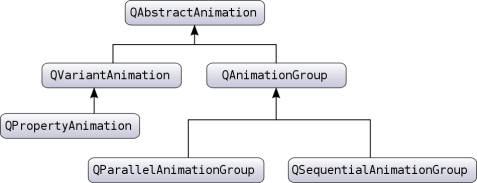
|
类名 |
功能介绍 |
|
QAbstractAnimation 动画基类 |
提供基本的动画属性和接口,它有两个子类QVariantAnimation 和QAnimationGroup。QAbstractAnimation是其他所有类的父类。它提供了基础的属性,适用于所有的本框架下的动画。 |
|
QPropertyAnimation 实际的动画类 |
,实现了一个Qt动画属性,比如对控件的大小缩放、位置移动、透明度变化的动画效果实现。修改的属性一定是类具有的属性,类中要有属性定义Q_PROPERTY(QRect geometry READ geometry WRITE setGeometry),否则要声明属性,并实践READ和WRITE方法。 |
|
QParallelAnimationGroup 并行动画类 |
将多个属性动画QPropertyAnimation添加到一个QParallelAnimationGroup,实现并行执行动画。 |
|
QSequentialAnimationGroup 串行动画类 |
QSequentialAnimationGroup,将多个QPropertyAnimation串联在一起实现,按照添加顺序先后执行动画。 |
|
QPauseAnimation停顿类 |
在串行动画中,添加一个暂停的动画,可以实现延时效果。 |
|
QEasingCurve速度曲线类 |
Qt动画运动的速度曲线,枚举了45种,详见附录。 |
2 基础动画实现
2.1 Qt控件大小缩放和位置变化
通过修改geometry属性实现坐标和大小的动画效果。通过创建QPropertyAnimation对象,关联widget控件ui.widgetProcess,设置属性geometry。QRect(x,y,width,hight),通过设置x,y改变位置,通过设置width和hight来改变大小。如下图所示,相似度widget向上移动同时隐藏。进度显示widget窗口从下往上移动,从隐藏到显示。




下面是坐标控制
QPropertyAnimation * pWidgetProcessUp = new QPropertyAnimation(ui.widgetProcess, "geometry");
pWidgetProcessUp->setDuration(300);//设置动画执行时间,单位毫秒
pWidgetProcessUp->setStartValue(QRect(140, 688, 534, 48));//初始值
pWidgetProcessUp->setEndValue(QRect(140, 668, 534, 48));//结束值
pWidgetProcessUp->setEasingCurve(QEasingCurve::Linear);设置速度曲线
pWidgetProcessUp->start(QAbstractAnimation::DeleteWhenStopped);//执行动画,结束后删除对象
2.2 透明度控制隐藏和显示
因为qt控件没有透明度属性opacity,所以需要通过QGraphicsOpacityEffect实现控件绘图效果实现透明度改变
头文件定义
QGraphicsOpacityEffect* m_widgetProcessOpacity;
构造函数中定义
m_widgetProcessOpacity=new QGraphicsOpacityEffect (ui.widgetProcess);//创建QGraphicsOpacityEffect对象关联控件ui.widgetProcess
m_widgetProcessOpacity->setOpacity(0);//设置透明度为0,隐藏控件
ui.widgetProcess->setGraphicsEffect(m_widgetProcessOpacity);//控件添加绘图效果
函数中使用
QPropertyAnimation* pWidgetProcessOpacity = new QPropertyAnimation(m_widgetProcessOpacity, "opacity", ui.widgetProcess);
pWidgetProcessOpacity->setDuration(300);
pWidgetProcessOpacity->setStartValue(0);
pWidgetProcessOpacity->setEndValue(1);
pWidgetProcessOpacity->setEasingCurve(QEasingCurve::Linear);
pWidgetProcessOpacity->start(QAbstractAnimation::DeleteWhenStopped);//执行动画,结束后删除对象。
2.3 并行动画
实际使用中需要将多个控件的属性动画一起执行,实现丰富的动画效果,将多个属性动画QPropertyAnimation添加到一个QParallelAnimationGroup,实现并行执行动画。例如将上面的两个动画合并,同时改变控件ui.widgetProcess的位置、大小、透明度。
QParallelAnimationGroup* pParaTwo = new QParallelAnimationGroup(this);
pParaTwo->addAnimation(pWidgetProcessUp);
pParaTwo->addAnimation(pWidgetProcessOpacity);
pParaTwo-> start(QAbstractAnimation::DeleteWhenStopped);//执行后删除
2.4 串行动画
可以实现同一个控件的不同属性变化串行,也可以实现多个控件的串行动画。还可以在动画之间添加暂停动画QPauseAnimation,实现延时的效果。
QSequentialAnimationGroup* pSequenAno = new QSequentialAnimationGroup(this);
//透明度从0变为1,显示出来;
pSequenAno->addAnimation(pWidgetProcessOpacity);
//暂停一秒
QPauseAnimation *pPauseAnimation = new QPauseAnimation(this);
pPauseAnimation->setDuration(1000);
//再向上移动
pSequenAno->addAnimation(pWidgetProcessUp);
pSequenAno->start(QAbstractAnimation::DeleteWhenStopped);
2.5 动画执行方向设置
Qt动画执行可以设置执行方向,为正向Forward和方向Backward,例如透明度变化正向是初始值setStartValue(0);结束值设置setEndValue(1);控件从隐藏到显示。可以设置动画执行方向为反向,pWidgetProcessOpacity –>s etDirection(QAbstractAnimation::Backward),这样就可以执行显示到隐藏的动画。动画的执行一般是双向的,可以通过方向控制,避免创建反向的动画流程。
enum Direction {
Forward,
Backward
};
2.6 动画循环次数设置
有时需要执行动画多次,或者无限循环下去,可以设置动画循环次数。设置为-1时表示无限循环。
void setLoopCount(int loopCount);
2.7 动画执行结束的操作
动画结束之后执行一些清理工作,或者属性设置工作,可以连接QAbstractAnimation::finished信号,动画结束之后再执行一些操作。也可以将动画对象的清理放入槽函数中。这样就不能start(QAbstractAnimation::DeleteWhenStopped);
connect(pSequenAno, &QAbstractAnimation::finished, [=]() {
ui.pushButtonAddVideo->setDisabled(true);
ui.pushButtonDelVideo->setDisabled(true);
ui.pushButtonAddPic->setDisabled(true);
ui.pushButtonDelPic->setDisabled(true);
PausePlayVedio(1, 0);//先创建索引,准确时间定位
});
3 Qt的高级动画应用
3.1 Qt自定义动画属性实现背景色透明度动画
自定义一个背景色透明度的属性,在定义get和set方法,在set方法中去通过setstytlesheet去设置背景色的透明度。
Q_PROPERTY(int alpha READ alpha WRITE setAlpha)
动画执行的过程中,通过set方法动态的设置背景色透明度。可以通过setKeyValueAt函数设置关键点的取值,step取值范围是0~1,可以设置几个值。动画执行过程中就会在这个几个值之间切换。
void setKeyValueAt(qreal step, const QVariant &value);
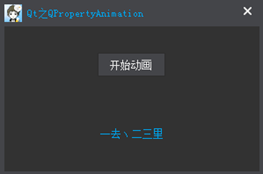
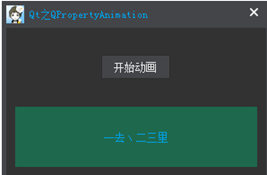
头文件实现
#ifndef MAIN_WINDOW_H
#define MAIN_WINDOW_H
...
class MainWindow : public CustomWindow
{
Q_OBJECT
Q_PROPERTY(int alpha READ alpha WRITE setAlpha)
public:
explicit MainWindow(QWidget *parent = 0);
~MainWindow();
private:
int alpha() const;
void setAlpha(const int alpha);
private:
int m_nAlpha;
QLabel *m_pLabel;
};
#endif // MAIN_WINDOW_H
源文件实现
#include "main_window.h"
MainWindow::MainWindow(QWidget *parent)
: CustomWindow(parent)
{
...
QPushButton *pStartButton = new QPushButton(this);
pStartButton->setText(QString::fromLocal8Bit("开始动画"));
m_pLabel = new QLabel(this);
m_pLabel->setText(QString::fromLocal8Bit("一去丶二三里"));
m_pLabel->setAlignment(Qt::AlignCenter);
m_pLabel->setStyleSheet("color: rgb(0, 160, 230);");
QPropertyAnimation *pAnimation = new QPropertyAnimation();
pAnimation->setTargetObject(this);
pAnimation->setPropertyName("alpha");
pAnimation->setDuration(1000);
pAnimation->setKeyValueAt(0, 255);
pAnimation->setKeyValueAt(0.5, 100);
pAnimation->setKeyValueAt(1, 255);
pAnimation->setLoopCount(-1); //永远运行,直到stop
connect(pStartButton, SIGNAL(clicked(bool)), pAnimation, SLOT(start()));
...
}
int MainWindow::alpha() const
{
return m_nAlpha;
}
void MainWindow::setAlpha(const int alpha)
{
m_nAlpha = alpha;
QString strQSS = QString("color: rgb(0, 160, 230); ").arg(m_nAlpha);
m_pLabel->setStyleSheet(strQSS);
}
注意事项:
(1)需要用QVariantAnimation检测你自定义的QVariant类型是否支持。
(2)声明属性的类必须是一个QObject,必须为属性提供一个setter(这样,QPropertyAnimation才可以设置属性的值)。
3.2 Tab条选择跟随移动
3.2.1 应用场景说明
如下图所示,初始状态,tab条在第一张图片下方,当鼠标放入第三张图片上时,触发了hover信号,tab条则会延长到第三张图片。如果单击第三张图片,tab条则会切换到第三张图片,如果没有单击则失去hover时,tab条还原到第一张图片。从而实现选择切换的动画显示。



3.2.2 实现方法
(1) 现在图片显示的自定义widget类中重写鼠标进入、离开、单击的函数,自定义三种信号,鼠标进入、离开、点击时触发信号传递到外面。
signals:
void signalPicClicked();//鼠标单击信号
void signalEnterPicWidget();
void signalLeavePicWidget();
protected:
void enterEvent(QEvent *e); //进入QWidget瞬间事件
void leaveEvent(QEvent *e); //离开QWidget瞬间事件
void mousePressEvent(QMouseEvent* e);
void enterEvent(QEvent *e); //进入QWidget瞬间事件
void leaveEvent(QEvent *e); //离开QWidget瞬间事件
(2) 将三种信号进行连接
for (int i = 0; i < 4; i++)
{
//鼠标进入信号绑定
connect(&m_Pic[i], &PicWidget::signalEnterPicWidget, this, [=]() {
//延长tab条到当前index
int iCurrentPosX = 164;
if (i != m_iCurrentPicIndex)//不是当前图片索引时才去延长
{
if (i == 0)
{
iCurrentPosX = 164;
}
else if (i == 1)
{
iCurrentPosX = 268;
}
else if (i == 2)
{
iCurrentPosX = 372;
}
else if (i == 3)
{
iCurrentPosX = 476;
}
QPropertyAnimation * linelength = new QPropertyAnimation(ui.line, "geometry");
linelength->setDuration(300);
QRect rect = ui.line->geometry();
linelength->setStartValue(rect);
linelength->setEasingCurve(QEasingCurve::Linear);
if (i<m_iCurrentPicIndex)//hover触发的图片在当前图片左边,x发生变化,同时长度向左延伸
{
linelength->setEndValue(QRect(iCurrentPosX, rect.top(), 32+ abs(i - m_iCurrentPicIndex) * 104, rect.height()));
}
else//hover触发的图片在当前图片右边,x不需要变化,长度向右延伸
{
linelength->setEndValue(QRect(m_iCurrentPosX, rect.top(), 32 + abs(i - m_iCurrentPicIndex) * 104, rect.height()));
}//执行动画
linelength->start(QAbstractAnimation::DeleteWhenStopped);
}
});
//鼠标放入之后没有点击而是离开了。还原位置
connect(&m_Pic[i], &PicWidget::signalLeavePicWidget, this, [=]() {
QPropertyAnimation * linelength = new QPropertyAnimation(ui.line, "geometry");
linelength->setDuration(300);
QRect rect = ui.line->geometry();
linelength->setStartValue(rect);
linelength->setEasingCurve(QEasingCurve::Linear);
if (i >m_iCurrentPicIndex)//坐标改变,同时向右延伸
{
linelength->setEndValue(QRect(m_iCurrentPosX, rect.top(),32, 4));
}
else//坐标不变只改变长度
{
linelength->setEndValue(QRect(m_iCurrentPosX, rect.top(),32, 4));
}
linelength->start(QAbstractAnimation::DeleteWhenStopped);
});
//鼠标单击后,切换位置,并且修改当前图片索引和当前位置值
connect(&m_Pic[i], &PicWidget::signalPicClicked, this, [=]() {
QPropertyAnimation * linelength = new QPropertyAnimation(ui.line, "geometry");
linelength->setDuration(300);
QRect rect = ui.line->geometry();
linelength->setStartValue(rect);
linelength->setEasingCurve(QEasingCurve::Linear);
if (i==0)
{
m_iCurrentPosX = 164;
}
else if (i==1)
{
m_iCurrentPosX = 268;
}
else if (i==2)
{
m_iCurrentPosX = 372;
}
else if (i==3)
{
m_iCurrentPosX = 476;
}
if (i>m_iCurrentPicIndex)
{
linelength->setEndValue(QRect(m_iCurrentPosX, rect.top(), 32, 4));//
}
else
{
linelength->setEndValue(QRect(m_iCurrentPosX, rect.top(), 32, 4));//
}
linelength->start(QAbstractAnimation::DeleteWhenStopped);
m_iCurrentPicIndex = i;
if (m_Pic[i].getPath()!="")
{
SourcePicChanged(m_Pic[i].getPath());
}
});
}
3.3 Qt实现数字滚动动画效果
3.3.1 应用场景说明
如下图所示,需要显示人脸检测的数量,变动画的方式实现个位数字滚动,个位由9变成0时,十位也要滚动,实现进位。当个位十位都是9时,数字不在增加,而是显示加号+。


3.3.2 实现方法
实现方案,个位十位都有上下两个label显示数字。通过QPropertyAnimation属性动画控制两个label位置同时向上。动画结束后,再将两个label还原到原始位置。在还原位置之前,先前上面的labelnum值设置为下面labelnum1的值,下面labelnum1的值设置为+1后的值,避免出现数字闪现变小的问题。
头文件实现
#ifndef NUMSHOWWIDGET_H
#define NUMSHOWWIDGET_H
#include <QPropertyAnimation>
#include<QParallelAnimationGroup>
#include <QSequentialAnimationGroup>
#include <QWidget>
#include"ui_NumShowWidget.h"
#include<QMutex>
#include<QWaitCondition>
#include<QTimer>
class NumShowWidget : public QWidget
{
Q_OBJECT
public:
NumShowWidget();
~NumShowWidget();
void initNum();//个位十位上下初始化0,1值
/*
设置为某个值,会根据数字增量的大小增加数字值,根据time求出平均动画时间步长。增量大时速度快,增量小时速度慢
*/
void setNum(int num,int time);
void addNum(int num, int time);
public slots:
void SlotTimeAddNum();
int getNum();
void pushNum(int num);
private:
Ui::NumShowWidget ui;
int m_tenwei = 0;//十位
int m_gewei = 0;//个位
QLabel* m_tenCurrent = NULL;//十位当前label
QLabel* m_tenDown=NULL;//十位下面的label
QLabel* m_geCurrent = NULL;//个位当前label
QLabel* m_geDown = NULL;//个位下面的label
int m_count = 0;//动画执行的次数,增量为10,则执行十次上滚动画
int m_num=0;//保存当前显示的数字。
QParallelAnimationGroup* tenAnimation;
QMutex m_mutex;
QWaitCondition m_FinishAnimation;
QTimer m_checktime;
QMutex m_addNumMutex;
QVector<int> m_vectNum;
bool m_bFinishAni=true;
QPropertyAnimation * tenCurrent =NULL;
QPropertyAnimation * tenDown = NULL;
};
#endif // NUMSHOWWIDGET_H
源文件实现
#include "NumShowWidget.h"
#include"hlog1.h"
#include<QFontDatabase>
NumShowWidget::NumShowWidget()
{
ui.setupUi(this);
setWindowModality(Qt::NonModal);
setWindowFlags(Qt::FramelessWindowHint);
this->resize(32, 32);
m_tenCurrent = ui.labelten;
m_tenDown = ui.labelten1;
m_geCurrent = ui.labelnum;
m_geDown = ui.labelnum1;
m_tenCurrent->setText("0");
m_tenDown->setText("1");
m_geCurrent->setText("0");
m_geDown->setText("1");
ui.labelplus->hide();
tenAnimation = new QParallelAnimationGroup(this);
tenCurrent = new QPropertyAnimation(m_tenCurrent, "geometry");
tenCurrent->setDuration(100);
tenCurrent->setStartValue(QRect(4, 0, 12, 32));
tenCurrent->setEndValue(QRect(4, -32, 12, 32));
tenAnimation->addAnimation(tenCurrent);
tenDown = new QPropertyAnimation(m_tenDown, "geometry");
tenDown->setDuration(100);
tenDown->setStartValue(QRect(4, 32, 12, 32));
tenDown->setEndValue(QRect(4, 0, 12, 32));
tenAnimation->addAnimation(tenDown);
connect(tenAnimation, &QAbstractAnimation::finished, this, [=]() {
m_tenCurrent->setText(QString::number(m_tenwei++));
m_tenCurrent->setGeometry(4, 0, 12, 32);
m_tenCurrent->raise();
m_tenDown->setGeometry(4, 32, 12, 32);
m_tenDown->setText(QString::number((m_tenwei + 1)));
});
m_checktime.setInterval(1000);
connect(&m_checktime, &QTimer::timeout, this, &NumShowWidget::SlotTimeAddNum);
m_checktime.start();
}
NumShowWidget::~NumShowWidget()
{
if (tenAnimation != NULL)
{
delete tenAnimation;
tenAnimation = NULL;
}
}
void NumShowWidget::initNum()
{
m_tenwei = 1;
m_gewei = 1;
m_num = 0;
m_tenCurrent->setText("0");
m_tenCurrent->setGeometry(QRect(4, 0, 12, 32));
m_tenDown->setText("1");
m_tenDown->setGeometry(QRect(4, 32, 12, 32));
m_geCurrent->setText("0");
m_geDown->setText("1");
m_geCurrent->setGeometry(QRect(15, 0, 12, 32));
m_geDown->setGeometry(QRect(15, 32, 12, 32));
ui.labelplus->hide();
m_vectNum.clear();
m_bFinishAni = true;
}
void NumShowWidget::setNum(int num, int time)
{
if (ui.labelplus->isVisible())
{
return;
}
m_num = ui.labelten->text().toInt()*10+ui.labelnum->text().toInt();
if (num <= m_num)//值没有变
{
m_mutex.lock();
m_bFinishAni = true;
m_mutex.unlock();
return;
}
addNum(num - m_num, time);
}
void NumShowWidget::addNum(int num, int time)
{
if (num <= 0)
{
return;
}
LOG_INFO("NUCOUNT LOCK");
int steptime = time / num;//动画时间步长
tenCurrent->setDuration(steptime);
tenDown->setDuration(steptime);
m_count = num;
QParallelAnimationGroup* paraAnimation = new QParallelAnimationGroup(this);
QPropertyAnimation * geCurrent = new QPropertyAnimation(m_geCurrent, "geometry");
geCurrent->setDuration(steptime);
geCurrent->setStartValue(QRect(15, 0, 12, 32));
geCurrent->setEndValue(QRect(15, -32, 12, 32));
paraAnimation->addAnimation(geCurrent);
QPropertyAnimation *geDown = new QPropertyAnimation(m_geDown, "geometry");
geDown->setDuration(steptime);
geDown->setStartValue(QRect(15, 32, 12, 32));
geDown->setEndValue(QRect(15, 0, 12, 32));
paraAnimation->addAnimation(geDown);
paraAnimation->start();
connect(paraAnimation, &QAbstractAnimation::finished, this, [=]() {
m_count--;
m_geCurrent->setText(QString::number(m_gewei++));
m_geCurrent->setGeometry(15, 0, 12, 32);
m_geCurrent->raise();
m_geDown->setGeometry(15, 32, 12, 32);
if (m_gewei >= 10)
{
if (m_tenwei < 10)
{
tenAnimation->start();
}
else
{
ui.labelplus->show();
m_mutex.lock();
m_bFinishAni = true;
m_mutex.unlock();
delete paraAnimation;
LOG_INFO("NUCOUNT ULOCK");
return;
}
m_gewei = 0;
}
m_geDown->setText(QString::number((m_gewei) % 10));
if (m_count > 0)
{
paraAnimation->start();
}
else
{
m_mutex.lock();
m_bFinishAni = true;
m_mutex.unlock();
delete paraAnimation;
LOG_INFO("NUCOUNT ULOCK");
}
})
}
void NumShowWidget::SlotTimeAddNum()
{
if (m_bFinishAni)
{
int num = getNum();
if (num > 0)
{
m_mutex.lock();
m_bFinishAni = false;
m_mutex.unlock();
setNum(num, 1000);
}
}
}
int NumShowWidget::getNum()
{
m_addNumMutex.lock();
if (m_vectNum.size() > 0)
{
int num = m_vectNum.front();
m_vectNum.pop_front();
m_addNumMutex.unlock();
return num;
}
else
{
m_addNumMutex.unlock();
return -1;
}
}
void NumShowWidget::pushNum(int num)
{
m_addNumMutex.lock();
m_vectNum.push_back(num);
m_addNumMutex.unlock();
}
3.4 QT图片旋转动画
3.4.1 应用场景说明
删除图片,图片旋转滚动到垃圾箱或者删除按钮时,需要有个滚动旋转的动画效果。需要用到QGraphicsView,QGraphicsScene,QGraphicsWidget,QLabel类,QGraphicsView类相当于黑色的框,和电视的外框类似,QGraphicsScene相当于动画播放区域,下图中的黑色框内部的白色区域,在这个白色区域内播放动画。QGraphicsWidget相当于是动画区域内的一个包装类,将QLabel写上文字或者通过setpixmap接口设置图片后,添加到一个QGraphicsWidget,将QGraphicsWidget添加到QGraphicsScene,QGraphicsScene放到QGraphicsView,就可以实现旋转图片或者文字的动画效果。
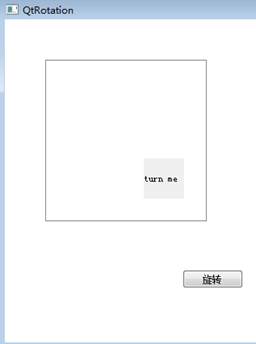
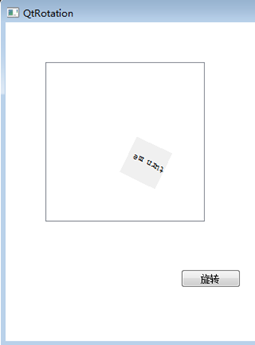
3.4.2 实现方法
(1) 定义旋转角度属性
头文件定义
#ifndef ROTATIONVIEW_H
#define ROTATIONVIEW_H
#include <QGraphicsScene>
#include <QGraphicsView>
#include <QGraphicsWidget>
#include <QTextEdit>
#include <QPushButton>
#include <QGraphicsProxyWidget>
#include <QGraphicsLinearLayout>
class RotationView : public QGraphicsView
{
Q_OBJECT
Q_PROPERTY(int angle READ turnangle WRITE setturnangle)//自定义角度属性
public:
RotationView(QWidget *parent);
~RotationView();
int turnangle() { return angle; };//get方法
void setturnangle(int angle);//set方法,动画会通过这个函数输入插值,使图片转动。
void startMove();
private:
QGraphicsView* view = NULL;
int angle=0;
QGraphicsWidget *pushButton = NULL;
};
#endif // ROTATIONVIEW_H
(2) 源文件实现
#include "RotationView.h"
#include<windows.h>
#include <QLabel>
#include <QPropertyAnimation>
#include <QRect>
RotationView::RotationView(QWidget *parent)
: QGraphicsView(parent)
{
//setWindowModality(Qt::NonModal);
setWindowFlags(Qt::FramelessWindowHint);
QGraphicsScene* scene = new QGraphicsScene(this);
// 创建部件,并关联它们的信号和槽
QPushButton *button = new QPushButton("clear");
QLabel* plabel = new QLabel("turn me");
// button->resize(100, 100);
button->setGeometry(0, 0, 100, 100);
// 将部件添加到场景中
pushButton = scene->addWidget(plabel);
scene->addItem(pushButton);
view = new QGraphicsView(scene,this);
view->setVerticalScrollBarPolicy(Qt::ScrollBarAlwaysOff);
view->setHorizontalScrollBarPolicy(Qt::ScrollBarAlwaysOff);
pushButton->setParent(view);
pushButton->setPos(100, 100);
view->resize(200, 200);
//view->setStyleSheet("border:0px;");
view->show();
//view->setStyleSheet("border:0px;");
//setturnangle(90);
}
RotationView::~RotationView()
{
}
void RotationView::setturnangle(int angle)
{
QRectF r = pushButton->boundingRect();
//for (int i = 1; i <= 100; i++)
//{
pushButton->setTransform(QTransform()
.translate(r.width() / 2, r.height() / 2)
.rotate(angle - 360 * 1, Qt::ZAxis)
.translate(-r.width() / 2, -r.height() / 2));
view->update();
//}
}
void RotationView::startMove()
{
QPropertyAnimation * linelength = new QPropertyAnimation(pushButton, "geometry");
linelength->setDuration(3000);
linelength->setStartValue(QRect(5,5,50,50));
linelength->setEndValue(QRect(100, 100, 50, 50));
linelength->setEasingCurve(QEasingCurve::Linear);
linelength->start(QAbstractAnimation::DeleteWhenStopped);
}
(3) 定义对象设置属性动画
#include "qtrotation.h"
#include"RotationView.h"
#include <QPropertyAnimation>
QtRotation::QtRotation(QWidget *parent)
: QMainWindow(parent)
{
ui.setupUi(this);
RotationView* roview = new RotationView(this);
roview->setGeometry(50, 50, 200, 200);
QPropertyAnimation* rotation = newQPropertyAnimation(roview, "angle", this);
rotation->setDuration(300);
rotation->setStartValue(0);
rotation->setEndValue(720);
rotation->setLoopCount(20);
rotation->setEasingCurve(QEasingCurve::Linear);
connect(ui.pushRotation, &QPushButton::clicked, this, [=]() {
roview->startMove();
rotation->start();
});
}
4 附录
4.1 Qt动画QEasingCurve的速度曲线
https://doc.qt.io/archives/qt-4.8/qeasingcurve.html
| Constant | Value | Description |
|---|---|---|
QEasingCurve::Linear |
0 |
 Easing curve for a linear (t) function: velocity is constant. |
QEasingCurve::InQuad |
1 |
 Easing curve for a quadratic (t^2) function: accelerating from zero velocity. |
QEasingCurve::OutQuad |
2 |
 Easing curve for a quadratic (t^2) function: decelerating to zero velocity. |
QEasingCurve::InOutQuad |
3 |
 Easing curve for a quadratic (t^2) function: acceleration until halfway, then deceleration. |
QEasingCurve::OutInQuad |
4 |
 Easing curve for a quadratic (t^2) function: deceleration until halfway, then acceleration. |
QEasingCurve::InCubic |
5 |
 Easing curve for a cubic (t^3) function: accelerating from zero velocity. |
QEasingCurve::OutCubic |
6 |
 Easing curve for a cubic (t^3) function: decelerating to zero velocity. |
QEasingCurve::InOutCubic |
7 |
 Easing curve for a cubic (t^3) function: acceleration until halfway, then deceleration. |
QEasingCurve::OutInCubic |
8 |
 Easing curve for a cubic (t^3) function: deceleration until halfway, then acceleration. |
QEasingCurve::InQuart |
9 |
 Easing curve for a quartic (t^4) function: accelerating from zero velocity. |
QEasingCurve::OutQuart |
10 |
 Easing curve for a quartic (t^4) function: decelerating to zero velocity. |
QEasingCurve::InOutQuart |
11 |
 Easing curve for a quartic (t^4) function: acceleration until halfway, then deceleration. |
QEasingCurve::OutInQuart |
12 |
 Easing curve for a quartic (t^4) function: deceleration until halfway, then acceleration. |
QEasingCurve::InQuint |
13 |
 Easing curve for a quintic (t^5) easing in: accelerating from zero velocity. |
QEasingCurve::OutQuint |
14 |
 Easing curve for a quintic (t^5) function: decelerating to zero velocity. |
QEasingCurve::InOutQuint |
15 |
 Easing curve for a quintic (t^5) function: acceleration until halfway, then deceleration. |
QEasingCurve::OutInQuint |
16 |
 Easing curve for a quintic (t^5) function: deceleration until halfway, then acceleration. |
QEasingCurve::InSine |
17 |
 Easing curve for a sinusoidal (sin(t)) function: accelerating from zero velocity. |
QEasingCurve::OutSine |
18 |
 Easing curve for a sinusoidal (sin(t)) function: decelerating from zero velocity. |
QEasingCurve::InOutSine |
19 |
 Easing curve for a sinusoidal (sin(t)) function: acceleration until halfway, then deceleration. |
QEasingCurve::OutInSine |
20 |
 Easing curve for a sinusoidal (sin(t)) function: deceleration until halfway, then acceleration. |
QEasingCurve::InExpo |
21 |
 Easing curve for an exponential (2^t) function: accelerating from zero velocity. |
QEasingCurve::OutExpo |
22 |
 Easing curve for an exponential (2^t) function: decelerating from zero velocity. |
QEasingCurve::InOutExpo |
23 |
 Easing curve for an exponential (2^t) function: acceleration until halfway, then deceleration. |
QEasingCurve::OutInExpo |
24 |
 Easing curve for an exponential (2^t) function: deceleration until halfway, then acceleration. |
QEasingCurve::InCirc |
25 |
 Easing curve for a circular (sqrt(1-t^2)) function: accelerating from zero velocity. |
QEasingCurve::OutCirc |
26 |
 Easing curve for a circular (sqrt(1-t^2)) function: decelerating from zero velocity. |
QEasingCurve::InOutCirc |
27 |
 Easing curve for a circular (sqrt(1-t^2)) function: acceleration until halfway, then deceleration. |
QEasingCurve::OutInCirc |
28 |
 Easing curve for a circular (sqrt(1-t^2)) function: deceleration until halfway, then acceleration. |
QEasingCurve::InElastic |
29 |
 Easing curve for an elastic (exponentially decaying sine wave) function: accelerating from zero velocity. The peak amplitude can be set with the amplitude parameter, and the period of decay by the period parameter. |
QEasingCurve::OutElastic |
30 |
 Easing curve for an elastic (exponentially decaying sine wave) function: decelerating from zero velocity. The peak amplitude can be set with the amplitude parameter, and the period of decay by the period parameter. |
QEasingCurve::InOutElastic |
31 |
 Easing curve for an elastic (exponentially decaying sine wave) function: acceleration until halfway, then deceleration. |
QEasingCurve::OutInElastic |
32 |
 Easing curve for an elastic (exponentially decaying sine wave) function: deceleration until halfway, then acceleration. |
QEasingCurve::InBack |
33 |
 Easing curve for a back (overshooting cubic function: (s+1)*t^3 - s*t^2) easing in: accelerating from zero velocity. |
QEasingCurve::OutBack |
34 |
 Easing curve for a back (overshooting cubic function: (s+1)*t^3 - s*t^2) easing out: decelerating to zero velocity. |
QEasingCurve::InOutBack |
35 |
 Easing curve for a back (overshooting cubic function: (s+1)*t^3 - s*t^2) easing in/out: acceleration until halfway, then deceleration. |
QEasingCurve::OutInBack |
36 |
 Easing curve for a back (overshooting cubic easing: (s+1)*t^3 - s*t^2) easing out/in: deceleration until halfway, then acceleration. |
QEasingCurve::InBounce |
37 |
 Easing curve for a bounce (exponentially decaying parabolic bounce) function: accelerating from zero velocity. |
QEasingCurve::OutBounce |
38 |
 Easing curve for a bounce (exponentially decaying parabolic bounce) function: decelerating from zero velocity. |
QEasingCurve::InOutBounce |
39 |
 Easing curve for a bounce (exponentially decaying parabolic bounce) function easing in/out: acceleration until halfway, then deceleration. |
QEasingCurve::OutInBounce |
40 |
 Easing curve for a bounce (exponentially decaying parabolic bounce) function easing out/in: deceleration until halfway, then acceleration. |
QEasingCurve::Custom |
45 |
This is returned if the user specified a custom curve type with setCustomType(). Note that you cannot call setType() with this value, but type() can return it. |